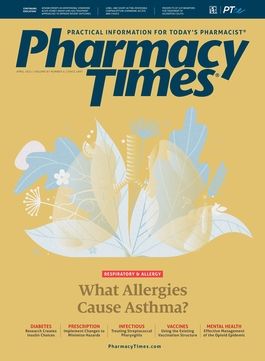Publication
Article
Pharmacy Times
Patients With Asthma Need an Action Plan
Author(s):
Pharmacists can play a vital role by offering inhaler counseling and helping improve adherence, especially during COVID-19.
Asthma is a common chronic lung disease that affects more than 25 million individuals in the United States.1
It is especially important during the coronavirus disease 2019 (COVID-19) pandemic to ensure that patients are prepared with at least a 30-day supply of their medications at all times.2 Individuals with moderate to severe asth- ma may be at higher risk of severe COVID-19 so pharmacists should edu- cate patients about the importance of frequent hand washing, getting the COVID-19 vaccine, social distancing, and wearing a mask.2 Pharmacists can play an important role in helping patients manage asthma and improving adherence (Figure).3-5

Pharmacists should make sure patients have a written asthma action plan that includes their medications with directions, measures to take if symptoms worsen, and how to access emergency medical care.3 Evidence shows that pharmacists can make a significant impact on asthma care and lower health care costs through medication therapy management (MTM) services.4,5
The Asheville Project was a longitudinal study that evaluated 207 adult patients with asthma over 5 years across 12 pharmacies with results showing individuals who received education and long-term MTM services had significant improvements.4 When the number of patients with asthma action plans increased to 99% from 63%, hospitalizations from asthma symptoms decreased from 4% to 1.9%.4 One pilot study examined the pharmacist’s role in asthma management in general practice.5 Over a 13-month time frame, a pharmacist treated 136 patients, with the most common activities involving asthma control assessment, device or medication recommendations, correct device use counseling, and asthma action plan development.5 The study results showed that the mean asthma control test score improved from the initial to last visit (P < .0001), which shows that pharmacist involvement can improve asthma management.5
It is important for pharmacists to also update patients and other health care professionals about asthma medication safety issues. For example, the FDA recently issued a drug safety communication regarding the addition of a boxed warning for montelukast (Singulair) about the risk of neuropsychiatric events, including agitation, depression, sleeping problems, and suicidal actions or thoughts.6 The benefits and risks should be weighed before patients are prescribed montelukast for asthma. Advise patients taking montelukast that if they experience any behavior or mood-related changes to discontinue the medication and contact a pharmacist and other health care providers immediately.6
In an interview, Tonna Alimole, PharmD, clinical adviser for a pharmaceutical market access company, discussed her experience with asthma management through medication and medical device education in community pharmacies and primary care practice settings. During MTM consults, she consistently reviewed the purpose of the inhaler(s), prescribed directions, and emphasized which medications were for long-acting control vs short-acting symptom relief.
“In a clinical office, I can pull up a video on the manufacturer’s website as an added visual aid on how to administer a dose,” Alimole said. “Otherwise, I find it is helpful just to go over the patient leaflet, which includes picture guides and information on how to prime and clean their inhaler.”
Other important counseling points include how to handle missed doses; rinsing the mouth with water after using steroid-containing inhalers to avoid oral fungal infections, such as thrush; and possible adverse effects and symptoms to report.
“I have the patient demonstrate how to use their inhaler, teach-back key points, and encourage them to reach out if they have any challenges,” says Alimole.
Cost is the most common factor causing adherence problems, and Alimole says she reviews patient insurance plans for lower-tier alternatives or shares manufacturer copay assistance programs to help patients.
Alimole discussed another common adherence issue with patients stopping use of their long-acting inhalers because they experience adequate relief from their short-acting medications or their asthma has improved.
“To address this, we review the importance of using their inhalers as directed to avoid exacerbations and maintain good control if this has been achieved. I also counsel such patients to work with their doctor or health care provider on stopping or [stepping down] therapy when appropriate,” Alimole said.
Case Study and Counseling Pearls
TM is a 46-year-old man with asthma at an MTM visit with the pharmacist. During the consult, the pharmacist creates an asthma action plan, which is divided into 3 zones: green, yellow, and red. The pharmacist explains that the green zone is where TM has no asthma symptoms and feels good. The yellow zone indicates that TM is experiencing symptoms and should follow the instructions to use his quick-relief medication. If TM is in the red zone, then he is experiencing severe asthma symptoms and should receive immediate medical treatment if the symptoms do not improve.
Jennifer Gershman, PharmD, CPh, is a drug information pharmacist and Pharmacy Times® contributor who resides in South Florida.
REFERENCES
- May is asthma awareness month. CDC. Updated May 4, 2020. Accessed January 8, 2021. https://www.cdc.gov/asthma/world_asthma_day.htm
- People with moderate to severe asthma. CDC. Updated January 20, 2021. Accessed March 11, 2021.https://www.cdc.gov/coronavirus/2019-ncov/need-extra-precautions/asthma.html
- Create an asthma action plan. American Lung Association. Updated January 22, 2021. Accessed March 11, 2021. https://www.lung.org/lung-health-diseases/lung-disease-lookup/asthma/living-with-asthma/managing-asthma/create-an-asthma-action-plan
- Bunting BA, Cranor CW. The Asheville Project: long-term clinical, humanistic, and economic outcomes of a community-based medication therapy management program for asthma. J Am Pharm Assoc (2003). 2006;46(2):133-147. doi:10.1331/154434506776180658
- Deeks LS, Kosari S, Boom K, et al. The role of pharmacists in general practice in asthma management: a pilot study. Pharmacy (Basel). 2018;6(4):114. doi:10.3390/pharmacy6040114
- FDA requires stronger warning about risk of neuropsychiatric events associated with asthma and allergy medication Singulair and generic montelukast. News release. FDA. March 4, 2020. Accessed January 9, 2021. https://www.fda.gov/news-events/press-announcements/fda-requires-stronger-warning-about-risk-neuropsychiatric-events-associated-asthma-and-allergy

Newsletter
Stay informed on drug updates, treatment guidelines, and pharmacy practice trends—subscribe to Pharmacy Times for weekly clinical insights.





